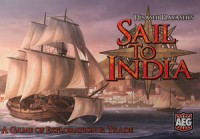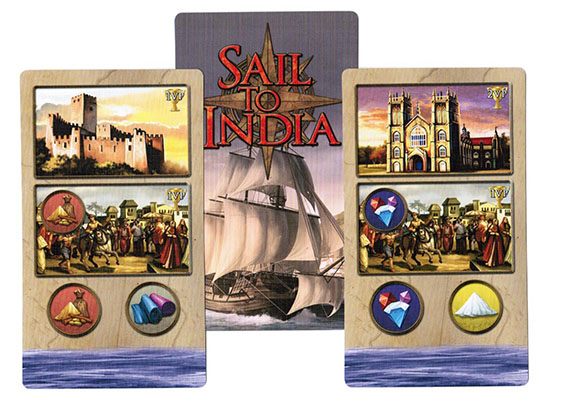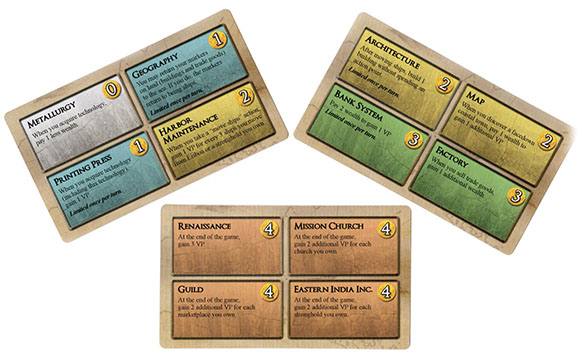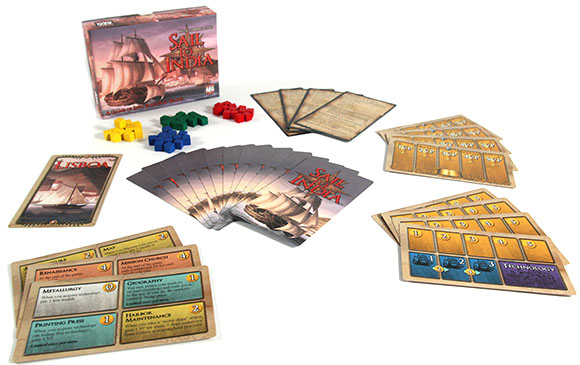
Sail to India
Overview
Portable games are getting increasingly popular, but they’re typically more theme than mechanics. Sail to India shakes things up, providing a “Euro” experience with minimal components. The theme won’t feel as strong as conquering kingdoms or discovering planets, but you’ll be surprised by all of the big-game mechanics they’ve managed to cram into such a small package.
Set Up
There are 24 tarot-sized cards in Sail to India that make up the playing surface in a 4-player game (only 19 cards are used in 3-player games). Thirteen of these cards – one card labelled “Lisboa” and twelve “Coastal Town Cards” – form the path to India you’ll randomly build each game.

Lisboa rests to the left of the central playing surface, and the Coastal Towns are shuffled face-down and laid in a line to the right of Lisboa. The first three Coastal Town cards are turned face-up prior to beginning the game. The remaining nine cards are the lands you’ll explore to ultimately reach India. Coastal Town cards are unlabeled; “India” is simply the right-most of these cards. For 3-player games you’ll only use nine of the Coastal Town cards, still revealing the first three. Each player places one of the 13 markers in their chosen player color onto the Lisboa card – this marker represents the lone ship you’ll start your fleet with.
Sail to India contains three “Technology” cards – these offer a worker-placement style set of upgrades players can prioritize or completely ignore as they choose. These are set out in ascending order (one card contains the cheaper upgrades, one contains expensive upgrades, and one in-between).
Each player needs to arrange their play area. This consists of a “Historian” card, a “Domain” card and four more markers in their player color. Historian cards track players’ victory points – you begin the game with none, so no marker is placed here during set-up.

Domain cards track three important details: your coins, maximum travel distance for your ships, and “scientist” pieces used via worker placement to upgrade your Technology. You must place one of your markers on the “1” space of your sailing distance track (indicating your ships may move only one spot per action) and three of your markers in the scientist section. You begin with no coins, so no marker is used there.
Now you’re ready to play!
Gameplay
Sail to India contains an amalgamation of several different gameplay mechanics. We’ve mentioned worker placement, but there’s an equal amount of set collection and light exploration. The one mechanic that rises above the others in terms of import to the game is resource management. And that resource in need of management is your player markers.
In Sail to India each player has 13 markers to utilize, but you’ll start with only five. The others will have to be earned through the game. The catch is that these markers are everything to you – they’re your victory points, your coins, your ships, your scientists… if you want more of one, you’ll have to sacrifice another. This brilliant tweak creates the challenge of the game – do you risk losing some victory points in the name of your fleet? You’ve worked hard for that silk… do you have to throw it away to explore the next uncharted land?

With this in mind, let’s walk through the actions you’ll choose from. You get two actions per turn, with no means to earn more.
- Employ marker: you’re starting the game with only one ship, and no marker on your victory point or coin tracks. You’ll need to get access to more of your markers as quick as possible to start earning money and building your fleet. But it costs 1 coin to employ a marker, and you start with none… so you’ll have to earn some change first.
- Move ships: the goal of Sail to India is to sail… to India, believe it or not. So you’re going to have to get those ships from Lisboa and through all of the Coastal Towns, and this is the way to do it. With one action you can move your entire fleet – each ship moving up to your current sailing distance (called “ship speed” below). You can take this action twice in a turn, but your ship must stop its movement – even if it has allowed distance left – if it encounters an “undiscovered” town (one still face-down). As part of this action your ships may become trade goods or buildings at their destination. Each Coastal Town card has two buildings on it and two trade goods – for the price of “on the house” your ship can move to one of the goods and become that commodity. For 2 coins your ship can move to one of the buildings and become that establishment. In either scenario, they cease to be ships.
- Sell trade goods: and here’s where you get your money. Any markers currently residing on a “trade goods” spot of a Coastal Town card can be sold to increase your coin supply. The amount earned graduates depending on the number of different goods you’re selling. There are six goods in Sail to India – if your sale features only one of them you get 1 coin, two will get you 2 coins and so on. Three or more goods sold will award a victory point or two in addition to coins. Once sold, the markers are returned to Lisboa and await their re-transformation into ships, coins, victory points, etc.
- Build buildings: each Coastal Town card contains two buildings, but they are very repetitive – they are all of only three types:
- Strongholds: worth 1 victory point at the end of the game, strongholds allow you to move ships directly from Lisboa to their location during the move ships action without using your distance allotment.
- Marketplaces: also worth 1 victory point at the end of the game, marketplaces contain a good you’ll be able to add to your sell trade goods action without having to return the marker to Lisboa.
- Churches: these are worth 2 victory points at the end of the game, but have no other function.
Regardless of type, each building costs 2 coins to “build”. Markers allocated to buildings are no longer in game circulation, so you’ll want to be careful. You CAN turn your buildings back in to ships, but doing so wastes the 2 coins and action spent to claim the building. With churches in particular it’s a good idea to wait until late in the game to claim them.
- Acquire technology: you have 3 “scientists” to start the game – markers located in the “technology” section of your Domain card. These 3 scientists are all you’ll get. With this action you move a scientist from your Domain card to an open spot on a Technology card of your choice. Each technology card contains four technologies (12 total) that range in cost from 0 to 4 coins. Each technology grants an important in-game advantage.
- Increase ship speed: you can upgrade the distance your fleet can travel during a “move ships” action. To upgrade from a distance of one town to two you’ll spend an action and 2 coins. To upgrade from a distance of two towns to three you’ll spend an action and 4 coins. You cannot do both upgrades with one action.

Game end is triggered when any player reaches India or when two players have claimed all of their markers. The player who triggered the end-game finishes their turn and each other player takes one more turn. A final tally is made – victory points from buildings are added to victory points on players’ Domain cards – and a victor is determined.
Components

The cards of Sail to India are not meant for shuffling or having in hand, but make up the playing surface. They’re large and durable, the few illustrations they contain help maintain the theme, and the “tarot” size makes it feel more like a board.
Outside of cards, the only components in Sail to India are 52 markers in 4 player colors. Nothing special here – they are standard “Euro” cubes.
Learning Curve
The ruleset of Sail to India is not the most complicated, but it is certainly no cake walk. While the rulebook is small, it’s smaller in size than content. There is a handful to learn about the way player markers act depending on where they’re currently located (ships behave differently than goods behave differently than scientists…) Keeping this straight may require a few rule book citings during your first play.
There is sufficient depth to Sail to India to require multiple plays to become adept at it. That’s truly remarkable for a game that fits in your pocket.
Who would enjoy this game?
Final Thoughts
Sail to India stands alone in its unique corner of gaming – a weird/unique hybrid of depth, mechanics and portability. For gamers who love deep gameplay as much as they love carrying a game in their pocket, this is going to be a huge hit. It’s not the deepest game… but it is certainly the deepest game you can conceal on your person.
It’s a “Euro” through-and-through, right down to it’s theme. The theme isn’t loose in Sail to India – in fact, the mechanics tie in pretty nicely, and you never feel like they could have slapped any old theme on the game. But like most Euros, it’s not exactly “sexy”.
It would have been nice to see more building types in the game. With two buildings apiece on each of the twelve Coastal Town cards – for a total of 24 buildings in the game – you’re going to see the same three buildings over and over.
If you are a lover of pocket games, there is nothing out there as deep as Sail to India.
User Reviews (2)
Add a Review for "Sail to India"
You must be logged in to add a review.

The designer of Trains tackles Euro-style worker placement in a remarkably compact and efficient exploration game with Sail to India.
The game comes in a small (4×6) box, similar to publisher AEG’s games in the “Five Minute Fun” line, but you get a delightfully strategic game in that same space. With a total of 28 cards (including four reference cards), 13 colored cube markers for each of four players, and a rulebook, the components are minimal. Each player receives a Domain card, which is used to record their current wealth, their ship speed, and to store any unused Technology markers; and a Historian card, which tracks Victory Points (VPs) earned during the game. The players each start with three markers on their Technology space, one marker to indicate a starting ship speed of 1, and one marker to track their wealth (variable depending on starting order). This leaves a total of eight markers per player in their stock, to be added over the course of the game. There are three cards indicating the Technology options available for purchase, which are used communally. One card represents the starting port for all players, Lisboa. The remaining twelve cards are used to form a line of coastal cities stretching east from Lisboa, only a few of which are known quantities at the start of the game.
On each player’s turn, they may take two actions from a series of available actions. These are:
– Employ a marker. By paying one wealth, the player may take a marker from their stock and place it on Lisboa.
– Move their ships. In a single action, the player may move any or all of their ships, which can be markers below a coastal town or idle markers in Lisboa, a number of towns west or east (left or right) up to their ship speed. As part of this move, one ship may be used to move onto and “discover” a face-down coastal town, and any ships that are in the sea area of a coastal town may be converted to trade goods by moving onto an unoccupied trade good space on the town card.
– Sell trade goods. A player may sell any or all markers which occupy trade good spaces on coastal towns; based on the number of different goods sold, the player earns an increasing amount of wealth and the possibility of gaining VPs. All markers sold move back to Lisboa and become idle, able to be employed in any fashion.
– Build a building. A player may pay two wealth to convert any marker on or below a coastal town card, moving it to an unoccupied building on the card. The three types of buildings are: Strongholds, which allow the player to start a Move Ships action from that town using any markers in Lisboa; Marketplaces, which represent a permanent trade good that add to any other trade good markers sold; and Churches, which are worth additional VPs at the end of the game.
– Acquire technology. A player may spend the cost of an unoccupied space on one of the three Technology cards to place one of their three Technology markers on that space. This gives the player a benefit which may affect their wealth, VP acquired, or VP totals at the end of the game.
– Increase ship speed. With one action, a player may pay an appropriate amount of wealth and increase their ship speed by one, to a maximum of three. This allows their ships to move across additional towns during a Move Ships action.
The game continues until either the final coastal town is flipped face-up, indicating that the passage to India has been discovered, or until two or more players have no unused markers remaining in their stock. Whoever triggered the endgame condition finished their turn, then each other player gets one more turn. VP are tallied up, including rewards for buildings and technologies, and a winner is declared.
The trick with this game is that nothing can be tracked until markers are employed, and that employed markers are interchangeable between jobs. Of the 13 markers each player receives, four are dedicated to tasks that cannot be changes: ship speed and technology. The remaining nine, including the starting Banker marker, are all fluid. If you earn VP, you must use one of your already employed markers (NOTE: NOT a marker from your stock) to track those VP on your Historian card. If you earn wealth, you will need to use an employed marker as a banker to track that wealth on your Domain card. These cards only go up to 5 each; if your VP or wealth increases past that number, you will need a second marker to track the higher number. Any employed markers which are no longer necessary — say, if you have seven wealth tracked with two markers, and spend down to five or below — go back to Lisboa as idle markers. These idle markers can then be used to become ships, Historian markers, etc. If at any point you need to track either VP or wealth, and you have no spare idle markers to do so, those untracked benefits are lost! You will need to carefully manage how your markers are employed — and how they might be shifted around during the course of your turn. A ship that becomes a trade good could be sold and immediately turned around to become a banker, as necessary.
Sail to India reflects the high quality of game that AEG is becoming known for, as their partnerships with international designers increase. The artwork is striking, and the lack of moving parts means it is a very clean, simple, and portable game. The layout of the game reflects the exploration theme very well. The card stock is very sturdy, and all of the same size, meaning cards will not slide around and become mixed up in the box. At a $20 price point, the game is highly affordable — it may seem like a small box, but there is a lot of game here at that price. I recommend this game highly for anyone who enjoys worker placement and resource management style games; it is simple yet strategic enough that other gamers may also enjoy it.
Pros:
High production values
Strong strategic replayability
Relatively easy to teach, difficult to master
Extremely portable
Turns play relatively quickly; not much downtime
Moderate (45-60 min) play time
Cons:
Only works with three or four players
Marker reusability can be confusing at first
What is remarkable about Sail to India is that it packs an incredibly big game in tiny box, both in terms of its theme and its sometimes harshly efficient Euro style game play. From the designer of String Railways and the Origins award winning Trains, Hisashi Hayashi, and published by Alderac Entertainment Group as part of its Big in Japan line, it is a game of mercantile exploration and adventurism. Designed for three to four players, aged twelve up, it is a game of resource management and worker placement that sees the participants attempt to sail to the orient in search of glory and riches.
Sail to India is set during the Age of Discovery. With the Mediterranean under Osman Turk control, the empire of Portugal seeks trade routes to the East. To do so, its merchants and nobles are dispatching explorers to sail south along the coast of Africa and round the Cape of God Hope in search of a route to India. Each player must manage his resources, and know when to invest in ships and technological advances, when to discover new ports and establish facilities, and when to reap the riches and the glory.
Thus Sail to India has big themes, but where a classic board game might come with a big board and counters to represent the ships and various goods and buildings. The little box that is Sail to India does it all with just twenty-eight large cards plus thirteen wooden cubes per player. Of these cards, three are given to each player. These are a Domain card, used to track a player’s wealth, the speed of his ships, and his technology; a Historian card, used to track a player’s Victory Points; and a Reference card. He also receives three cubes to invest in technology, one to track his ships’ speed (initially one, but can be bought up to three), and starting wealth (varies upon starting order). This leaves eight cubes, which essentially represent investments that a player can make as ships, goods, buildings, wealth, and glory (Victory Points).
Of the remaining cards, they form the route to India, consisting of coastal towns along the coast of Africa. Each Coastal Town consists of two buildings—churches, markets, and strongholds—which grant Victory Points when built, trade goods that can be sold for wealth and Victory Points. and the sea. They are laid out in a line, with Lisboa at one end, followed by the coastal towns, of which three start face-up. They are known destinations. The others will be revealed as ships sail further and further until the last, India, is reached. At game start each player also places one of his cubes as a ship on Lisboa.
On his turn, a player has several options, but can only do two of them. These include employing markers, moving ships, selling trade goods, constructing buildings, acquiring technology, and increasing ship speed. Employing ships means taking a cube from a player’s stock and paying one wealth to turn it into a ship in Lisboa. Moving ships involves a player moving any or all of his ships in any direction, up to his ships’ speed. If he moves his ships into a new coastal town, it is turned over and he earns Victory Points. To sell trade goods, a player moves his ships from the sea into the trade good spaces on the coastal towns. These are sold for wealth and Victory Points, the greater the number of types of good, the greater the reward. The markers for the trade goods are returned to Lisboa. For two wealth, a player can turn a ship into a building which now belongs to that player—churches give two Victory Points; markets only give one, but serve as a permanent trade good; and strongholds also only give one, but also serve as a starting point instead of Lisboa. To acquire technology, a player pays the coast and places a technology marker on the correct space on the technology cards. There are three of these cards, giving a total of twelve technologies. They have various effects, such as Printing Press giving a Victory Point when a technology is acquired, the Factory giving extra wealth when trade goods are sold, or Mission Church giving extra Victory Points for churches built. A technology can only be purchased once. Lastly, a player can increase his ships’ speed, first to two, and then three.
Play lasts an hour. It ends when the last coastal town is turned over and India is discovered, or when two players have run out of cubes. After that, everyone gets another turn and the game ends.
What makes Sail to India challenging is three factors. First, a player only has eight cubes to use as ships, trade goods, buildings, and so on. Second, they are interchangeable—ships can become trade goods which become ships, ships become buildings, and so. Third, a player needs to use some of these cubes to track his wealth and Victory Points, and since the tracks for both only go up to five, if a player earns enough to have six or more wealth or Victory Points, then he needs extra cubes—which have to come from those in play and from those in stock. If a player no cubes in play available, then he cannot track this extra wealth or Victory Points. Essentially, keeping track of his wealth and his glory (Victory Points) takes effort as reflected by the need for the extra cubes.
Sail to India is nicely presented. The cards are easy to use, the reference cards are very handy, and the rules clearly written. The artwork is in keeping with the game’s enjoyable theme, which is elegantly implemented in the game play. Similarly elegant is the balance between taking actions and using cubes and using cubes to keep track of a player’s wealth and Victory Points. Above all, Sail to India packs a lot gameplay and choices in quite a small box.